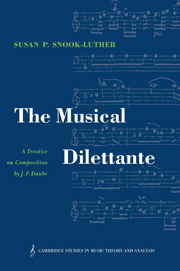Book contents
- Frontmatter
- Contents
- Foreword
- Translator's preface
- Introduction
- THE MUSICAL DILETTANTE: A TREATISE ON COMPOSITION (1773)
- Preface
- 1 Harmony in general
- 2 The three different motions of the voices
- 3 Combining two voices
- 4 Combining three voices
- 5 Combining four voices
- 6 Composition in five and more parts
- 7 Variation
- 8 Imitation
- 9 Canon
- 10 Simple fugue
- 11 Double counterpoint
- 12 Double fugue
- Bibliography
- Index
9 - Canon
Published online by Cambridge University Press: 15 October 2009
- Frontmatter
- Contents
- Foreword
- Translator's preface
- Introduction
- THE MUSICAL DILETTANTE: A TREATISE ON COMPOSITION (1773)
- Preface
- 1 Harmony in general
- 2 The three different motions of the voices
- 3 Combining two voices
- 4 Combining three voices
- 5 Combining four voices
- 6 Composition in five and more parts
- 7 Variation
- 8 Imitation
- 9 Canon
- 10 Simple fugue
- 11 Double counterpoint
- 12 Double fugue
- Bibliography
- Index
Summary
In the preceding discussion we spoke of the imitation of a musical motif. The present discussion has to do with the entire piece. The canon is a melody which has been contrived in such a way that the second voice might be able to enter at a chosen distance after the first, and to imitate most strictly all the previously heard tones of this melody throughout the entire piece. When pieces of this kind have a spontaneous melody they are always worthy of praise, but as soon as even the slightest constraint is evident, it is better that one choose the free style of writing.
The canon is divided into many different classes, of which we want to point out the most important. The simplest type of all is that in which the second voice imitates all the tones of the first voice, and the entire piece consists of only two voices. This type is very easy to construct. One writes down an initial melody of only one measure. After this one writes this measure in the second voice, and again invents a first voice to go with it. This in turn is written in the second voice, for which one again seeks out a harmonizing upper voice, which then once more is set in the second voice. One proceeds with the continuation of the first voice and the repetition in the second voice in such a way for as long as desired.
- Type
- Chapter
- Information
- The Musical DilettanteA Treatise on Composition by J. F. Daube, pp. 156 - 186Publisher: Cambridge University PressPrint publication year: 1992



